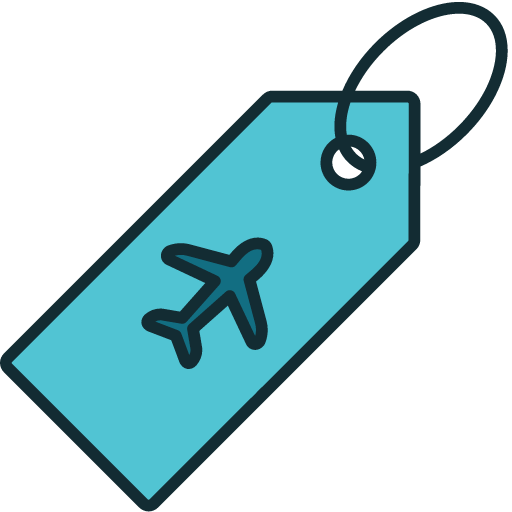THAILAND TRAVEL TIPS FOR FIRST-TIME VISITORS
“The world is a book and those who do not travel read only a page. ”
~ Saint Augustine
A QUICK GLANCE AT
THAILAND TRAVEL ESSENTIALS
All the information you need to plan your first trip to Thailand is here. From whether you’ll need a Thai visa, to which areas to stay in Bangkok and especially where to eat and shop have all been researched for you.
This is everything you need to know before arriving in Thailand for your first epic visit.
MAIN MENU
- BEST TIME TO VISIT
- DO I NEED A VISA?
- THAI HOTELS
- VACCINES AND HEALTH
- TRAVELING WITH KIDS
- BKK & DMK AIRPORTS
- THAI MONEY
- GETTING AROUND
- FOOD IN THAILAND
BEST TIME TO VISIT THAILAND
Two questions might’ve crossed your mind while contemplating a trip to Thailand:
1) HOW HOT WILL IT GET?
2) WILL IT RAIN A LOT?
Answer to Thailand’s Weather In One Paragraph:
Most of the year Thailand is warm. With April the hottest month. Rain season starts during middle parts of the year beginning with April. It ends in September as the wettest and most humid month. The cool season starts mid November with a week in January reaching the coolest point, particularly in northern Thailand.
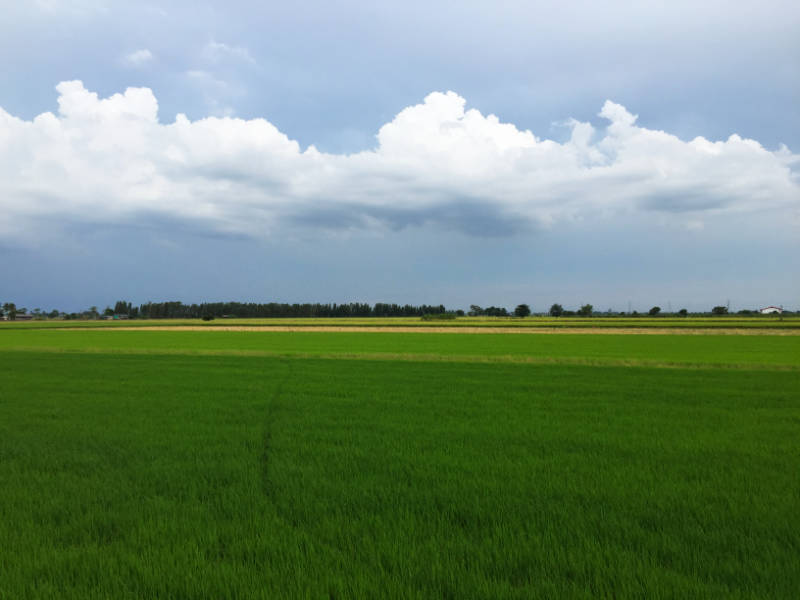 Rain is important in Thailand as rice farming is central to Thai economy.
Rain is important in Thailand as rice farming is central to Thai economy.
If a single paragraph is not enough then check out my nifty little Thailand weather chart below. Where you also find the best months to visit Thailand’s beaches and islands.
A BREAKDOWN OF WEATHER IN THAILAND
HOT (MARCH – JUNE)
RAINY (MAY/JUNE – OCTOBER)
COOL (NOVEMBER – FEBRUARY)
BEST MONTHS TO VISIT THAILAND’S BEACHES AND ISLANDS
HOT (MARCH – JUNE)
March thru June (Bangkok averages 34°C to 40°C or 93.2°F to 104°F) are the hottest months of the year. Don’t let the high temps deter you from visiting Thailand.
Unless you’re out in the boonies, Thailand’s major cities and beach destinations will always have places to pop in and cool down with air conditioning. You can chill out inside a shopping mall that always have air conditioning on full blast.
Cool down inside one of Thailand’s many cafés and coffee shops. Personally if the heats to much to take I like standing next to the drink refrigerators inside 7-Eleven. There are so many 7-Elevens in Thailand, that if you threw a rock in any direction, you’re bound to hit two convenience stores.
Songkran is the Thai New Years and takes place middle of April. Most small business are closed for this major Thai holiday. Local citizens either go home to the outer provinces to visit family or enjoy traveling in country.
Most major malls and shopping centers operate business as usual to the point you can’t tell a major holiday in under way.
April is reportedly the hottest month in Thailand. Part of Songkran Water Festival is the ritual of dousing water on willing and unwilling participants to cleans a path for the new year.
RAINY (MAY/JUNE – OCTOBER)
If you’re on a budget and want to save money on a Trip to Thailand, May through September will be the best time for you to visit. The month of May is the start of the monsoon season with slight dip on the temperature scale from April, which is reportedly the hottest month in Thailand.
Starting from May/June expect heavy rains mostly during the afternoon and evenings. Temperature in Bangkok hovers around 30°C to 32°C or 86°F to 89.6°F.
TheWayfaringSoul Travel Tip #151: Leave your rain poncho at home. It will protect you from the rain. But you’ll get soaked nonetheless from sweating.
Torrential rain brings the temps down a notch. But with the high heat index the humidity is incredibly uncomfortable. It’s a good idea to have a sturdy compact umbrella to fend off heavy rain or use as shade.
September is the wettest month in Thailand with sporadic or consistent downpours throughout the month. With a whopping 332.7mm or 13.1inches of rain.
Don’t let the rainy months scare you off from visiting Thailand. Street floods is a fact of life today in cities like Bangkok and Hua Hin where tourists are likely to stay.
Best to leave your favorite shoes at home and travel in Thailand with a pair of sturdy sport sandals that you can wear on the streets or on the beach.
It’s not until the tail end of October when the temperatures begin to get cooler especially at nights.
COOL (NOVEMBER – FEBRUARY)
The best months to visit Thailand for sightseeing is from November to February. It’s no coincidence that Thailand’s peak travel season coincides with the cool season. Hotels in Thailand cost more during high season. Don’t worry though you’re going to find the right hotel for the right price November to February.
Special events and gatherings like Jai Thep’s outdoor 3 day festivities in Chiang Mai take advantage of the cooler northern temps in January. Also Maya Music Festival puts on a crazy hot party in Pattaya at the end of January.
November is the start of Thailand’s cool season on record. The northern cities of Chiang Mai and Chiang Rai see daytime temps of 30°C or 86°F. But night night the thermometer drop down to 18°C or 64.4°F. While in January the temps can get down to 14°C and in some instances lower in the north.
Day time temps in central Bangkok are a few degrees higher than the north but at night Bangkok can go down to 22°C or 71°F.
During the start of November on the west of Thailand on the Andaman Sea, Phuket sees day time temps of 32°C or 82.4°F. With night time temps dipping to 25°C or 77°F. But there’s a lot of rain during the month of
Heading down south to the gulf of Thailand, Koh Samui temps remain cooler at 28°C or 82.4°F in November.
Even though November through February are traditionally the best months to visit Thailand overall, the cooler temperatures are entirely dependent on the weather system up north in China.
BEST MONTHS TO VISIT THAILAND’S BEACHES AND ISLANDS
THAILAND’S ANDAMAN SEA AND COAST
For clear, calm waters ideal for snorkeling, scuba diving and boating; November through April are the best months for activities and touring around Phuket and the surrounding islands.
THAILAND’S WEST COAST (THE ANDAMAN SEA)
Months of September and early October are the worst months to visit Phuket and the rest of the islands in Thailand’s Andaman Sea. Thailand doesn’t have a world class surfing scene, though April through October is the best time to go to Thailand for surfing. The best beaches for surfing are on the west coast of Phuket Island.
- Phuket
- Phi Phi Islands
- Krabi
- Similian Islands
- Racha Islands
- Coral Island
- Koh Yao Yai and Koh Yao Noi
- Koh Khai Islands
- Koh Bon
The Wayfaring Soul Travel Tip# 76: Koh (also spelled Ko) in Thai (เกาะ) means island.
THAILAND’S EASTERN GULF SEA AND COAST
There’s are fewer islands on the western coast of Thailand. The most popular beach on this side of Thailand is by the city of Hua Hin, 144 kilometers from central Bangkok.
Best months to visit Hua Hin are between November through February. Which is also true for the beaches listed below.
The most famous island on the eastern gulf of Thailand is Koh Samui and the best time to visit Koh Samui is from December to early April.
- Khao Takiab Beach
- Suan Son Pradiphat Beach
- Khao Tao Beach
- Cha Am Beach
- Hua Hin Beach
- Koh Samui
- Koh Phagnan
- Koh Ta
THAILAND VISA INFORMATION
For tourism purposes, depending on your nationality, you can receive 14 to 90 with no visa requirements.
Most Western and developed East Asian nations receive 30 days stay as part of a tourist visa exemption scheme promoting tourism in Thailand.
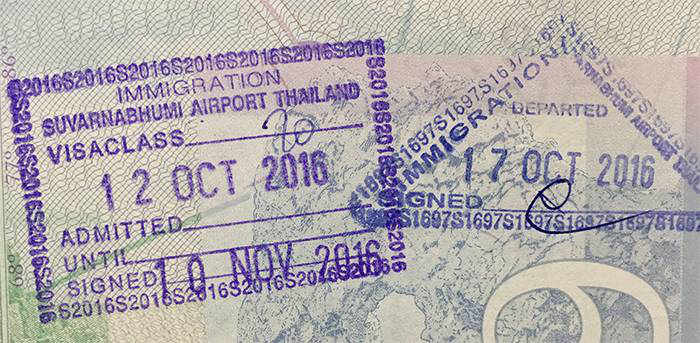 Left is an entry stamp with October 12, 2016 is the entry date, November 10, 2016 is the exit date. Stamp on the right is the exit stamped October 17th, 2016
Left is an entry stamp with October 12, 2016 is the entry date, November 10, 2016 is the exit date. Stamp on the right is the exit stamped October 17th, 2016
MOST PASSPORT HOLDERS WITHOUT VISAS CAN APPLY FOR 30 EXTENSION
For 1900THB fee most nationalities are able to extend their stays for an additional 30 days at the nearest Thai immigration bureau for tourism. If you’ve exceeded your exit date then you are considered as overstay and will not be able to apply for extension.
Thai immigration is becoming strict on tourists abusing visa exemption schemes. If you wish to tour Thailand longer for 6 months (possibly 9 months) I recommend applying for a Multi-Entry Thai Visa at the Thai embassy or consulate in your home country.
COUNTRIES GRANTED 30 DAYS STAY WITHOUT VISA
Passport holders from countries listed below can stay in Thailand for 30 days, with no visa.
1. Andorra
2. Australia
3. Austria
4. Belgium
5. Bahrain
6. Brunei
7. Canada
8. Czech Republic
9. Denmark
10. Estonia
11. Finland
12. France
13. Germany
14. Greece
15. *Hong Kong
16. Hungary
17. Iceland
18. Indonesia
19. Ireland
20. Israel
21. Japan
22. Kuwait
23. *Laos
24. Latvia
25. Liechtenstein
26. Luxembourg
27. *Macau
28. Malaysia
29. Maldives
30. Mauritius
31. Monaco
32. *Mongolia
33. Netherlands
34. New Zealand
35. Norway
36. Oman
37. Philippines
38. Poland
39. Portugal
40. Qatar
41. *Russia
42. Singapore
43. Slovak
44. Slovenia
45. Spain
46. South Africa
47. Switzerland
48. Sweden
49. Turkey
50. Ukraine
51. UAE
52. UK
53. USA
54. *Vietnam
* Bilateral Agreement
COUNTRIES GRANTED 90 DAYS STAY WITHOUT VISA
Passport holders from countries listed below can stay in Thailand for 90 days, with no visa.
1. Argentina
2. Brazil
3. Chile
4. South Korea
5. Peru
COUNTRIES GRANTED 14 DAYS STAY WITHOUT VISA
Passport holders from countries listed below can stay in Thailand for 14 days (Bilateral Agreement).
1. Cambodia
2. Myanmar
NATIONALS ALLOWED VISA ON ARRIVAL (VOA)
Passport holders from countries listed below can apply for VOA for 2000THB fee and allowed to stay for 15 days.
1. Bulgaria
2. Bhutan
3. China
4. Cyprus
5. Ethiopia
6. Fiji
7. Georgia
8. India
9. Kazakhstan
10.Malta
11. Mexico
12. Nauru
13. Mauritius
14. Papua New Guinea
15. Romania
16. Saudi Arabia
17. Taiwan
18. Uzbekistan
19. Vanuatu
OVERSTAY FEES AND PENALTIES
If somehow you ended up overstaying in Thailand one day after your exit date there’s a penalty fee of 500THB fine for everyday overstayed. With up to a maximum of 40 days or 20,000THB in fines. This fine is paid at the immigration office at the airport or a borderland crossing.
Though here’s an article making an interesting point that the Thai overstay fine won’t go into effect until after the first day of overstaying. In either case, it’s best to exit Thailand by the date that is stamped on your passport.
Overstay 90 days and you’ll get blacklisted from entering Thailand for a year.
DO I NEED TO CARRY MY PASSPORT AROUND IN THAILAND?
No, it’s not necessary to carry your passport where ever you go in Thailand. You do need to show your passport upon checking in to your hotel. It’s still your primary form of identification.
You should carry black and white photocopies of your passport. And leave your passport inside hotel room safe or hotel’s safety deposit box.
A photocopy of the photo page, stamped entry page with your departure card (more about departure card below) is sufficient.
Take photos of the same pages with your camera’s phone. And send a set to your email account as a precautionary backup.
Legal drinking age in Thailand is 20 years. If you get carded a driver’s license or your country’s government issued I.D. card should be sufficient.
WHERE TO BOOK HOTELS AND HOSTELS IN THAILAND
Thailand has some of the best quality hotels in the world. And most are surprisingly affordable. You’ll find quaint little bungalows by the beach for long stay. To luxurious 5 star hotels overlooking a river with a sunset.
Budget hostels are most popular with young backpackers as well as older travelers. Don’t count out budget hotels in Thailand. For a little extra you can have a private room and bathroom without the sharing.
The best website to book hotels in Thailand is with Agoda.com. I can also recommend Booking.com, but for booking hotels in Asia region, Agoda is better.
VACCINES AND HEALTH
Do I Need Vaccines for Thailand?
There’s a good chance you’ve already have the necessary and most important vaccinations such as polio, measles, mumps and influenza.
For traveling around Thailand for a long extended period of time according to the CDC, hepatitis A and hepatitis B vaccinations are recommended.
Malaria in Thailand is a concern especially in hilly or forested areas. Most major tourist destinations and resorts such as Bangkok, Chiang Mai, Phuket, Koh Samui and Hua Hin have no reported cases of malaria
If you are planning to head into heavily forested areas applying mosquito repellent with long shirt and pant is good advice.
HOSPITALS AND MEDICAL CARE QUALITY
Every major city in Thailand has least one hospital with international standards. The capital city of Bangkok has the most. Though the country has a total of 69 medical hospitals, clinics, dental and cosmetic verified by Joint Commission International for quality standards.
Cost of medical care in Thailand is very affordable. Prescription medicine are very affordable as well. Most, even antibiotics can be purchased over the counter by licensed Thai pharmacies at reasonable prices as also.
But accidents might happen so having some travel insurance purchased from your home country might come in handy. If you’re taking an organized tour in Thailand through a Thai tourist agency, for example island hopping in Phuket, licensed tour agencies are required to provide travel insurance included with tour price.
TRAVELING WITH KIDS
Let’s face it, your kids prefer going to Disney World instead of Thailand. That’s why you have to show them these websites of Siam Amazing Park and Dream World.
And to beat the heat and chill out with cute penguins take them to Siam Ocean World inside Siam Paragon Shopping Center to enjoy food and shopping.
And there’s always the wonderful beaches and islands of Thailand. Your kids will certainly enjoy playing on the beach and snorkeling.
Though I firmly believe if you truly want to immerse your child into another culture perhaps taking a private tour with a local Thai expert. That can show you a floating market or perhaps how Thai farmers grow rice.
It’ll be an eye opening and life learning experience your young ones will never forget.
BKK AND DMK AIRPORTS
LANDING IN THAILAND’S MAJOR INTERNATIONAL AIRPORTS
Thailand has six international airports run by Airport of Thailand. Most international travelers will be arriving into Bangkok, which has two international airports welcoming the most foreign tourists around the world into Thailand.
SUVARNABHUMI INTERNATIONAL AIRPORT (Airport Code: BKK)
Most Western and Asian major airline carriers land in Thailand’s Suvarnabhumi (pronounced Su-wana-poom) International Airport.
Acting as a gateway to neighboring Southeast Asian countries Suvarnabhumi is the largest airport in Thailand servicing the bulk of international visitors. It is also a regional airport with daily local flights serviced by Thai Airways, the country’s flag ship airline.
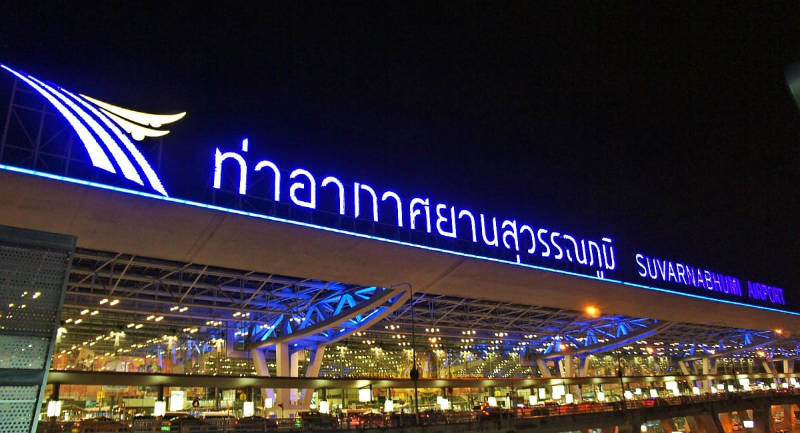 Suvarnabhumi Airport is Thailand’s major international airport
Suvarnabhumi Airport is Thailand’s major international airport
DON MUEANG INTERNATIONAL AIRPORT (Airport Code: DMK)
The second largest airport in Thailand is Don Mueang International. Mainly a regional airport handling daily flights all across Thailand. Due to Thailand’s popularity among travelers in the ASEAN region, Don Mueang was expanded to handle international flights from low cost airlines most notably Air Asia.
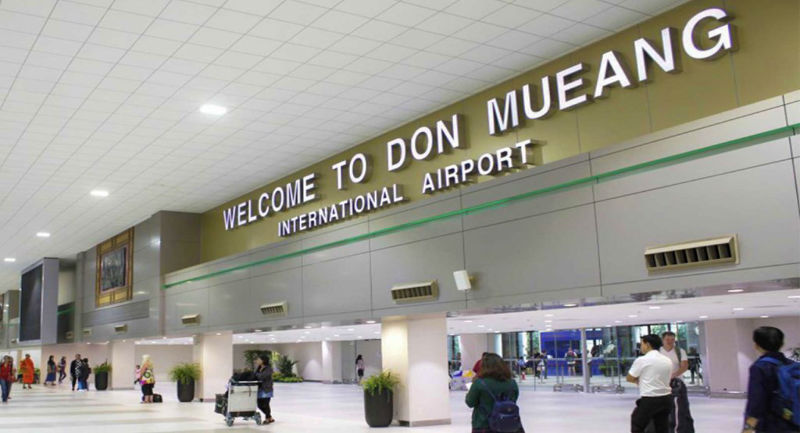 Inside Don Meuang International Airport
Inside Don Meuang International Airport
FREE AIRPORT TRANSFERS
Free transfer shuttle buses between both airports provided you show your onward tickets. These shuttle buses are spacious and can accommodate large luggage.
Service is based on first come first serve and you can’t make reservations.
Airport shuttle buses operate between 5:00am to midnight, everyday. There is frequent service with shuttle buses running every 10 to 30 minutes depending on time of day.
Road distance between both airports is 46 kilometers. Under normal traffic conditions the trip takes 1 hour. It can take 2 hours through rush hour and rainy conditions.
So plan your flight connections accordingly.
Though if you are in hurry to make a connecting flight use the metered taxis and tell the driver to use the highway.
FROM THE AIRPORTS TO CENTRAL BANGKOK
Both airlines provide fairly easy access to central Bangkok. Though currently Suvarnabhumi Airport is the only airport with an Airport Railway Link (ARL) that takes travelers to the center of Bangkok in 30 minutes.
The ARL is located in the basement level of Suvarnabhumi Airport and a one way fare cost 45THB to BTS Phaya Thai Station. ARL one way fare to Makkasan Station for connecting to MRT Petchaburi station cost 35THB.
Bangkok’s public bus systems has improved dramatically these days. New buses have rolled out with signage of stops in English. Though translations still need some work. Bus drivers and fare collectors inside buses are most likely unable to communicate in English.
Airport bus stops are clearly marked and you will not have a problem finding the location near the airport.
Metered taxis are the most convenient and a relatively inexpensive way to get to your hotel from the airport.
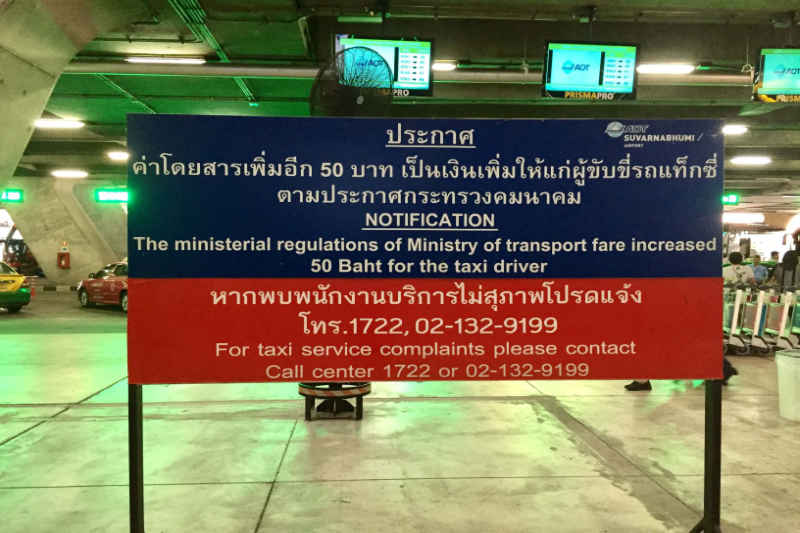 As a service fee at BKK and DMK airports, 50THB is added on top of the metered fare and paid to taxi driver.
As a service fee at BKK and DMK airports, 50THB is added on top of the metered fare and paid to taxi driver.
Cost of Metered Taxis from the Airports
Taxi fare from BKK airport to central Bangkok cost approximately between 250THB to 300THB. Taxi fare to the Khao San road is approximately 400THB.Metered taxi from DMK to central Bangkok is around 50THB less because it’s closer to the inner city.
Taxi drivers might suggest taking tollways to passengers to reach a destination quicker. If so you can add an additional 100THB on top of the taxi fair.
Cost of a taxi fare from both airports to central Bangkok is reasonable.
Especially if you’re traveling with 2 to 3 other people. A standard metered taxi sedan can accommodate 3 to 4 adults. Keep in mind luggage space will be limited the more persons you travel with.
Remember, there is a 50THB airport surcharge to be added on top of the meter.
Both airports have an organized metered taxi system queue with signs in English pointing to the public taxi queue.
THAI MONEY
The official unit of Thai currency is the Baht. You may see it abbreviated as; B or THB or as this symbol ฿ and also written in Thai at local markets and food vendors บาท.
There are only 4 common notes; 20THB, 50THB, 100THB, 500THB and 1000THB
There are only 4 coins; 1THB, 2TBH, 5THB and 10THB
There are a few other smaller coin denominations called ‘satang’ but they are mainly used in large supermarkets and sometimes 7-Elevens.
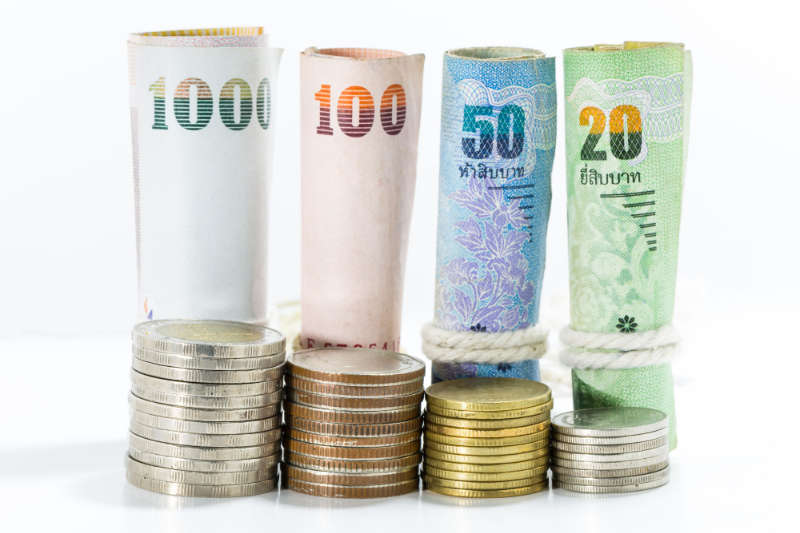
USING CREDIT CARDS
Currently Thailand is still primarily cash based. Credit cards, particularly Visa and MasterCard are in all major Thai and foreign owned businesses, including medical facilities. Most vendors inside Chatuchak Weekend Market accept credit card payments. But always keep cash in hand
American Express is only accepted in major shopping centers like Siam Paragon and Central branded malls. International branded hotels like the Hyatt, Marriott, Westin and Sheraton accept American Express as well.
Smaller local businesses like hair salons and nail salons may accept credit card payments but might tack on 3% surcharge to cover transaction costs. Which is not bad considering how expensive it is to withdraw Thai Baht from ATMs in Thailand.
WHERE TO GET THAI BAHT?
THAI ATMS
Automatic Teller Machines aren’t difficult to find in Thailand. Particularly inside major cities and all over popular tourist destinations. But withdrawing cash from a Thai ATM fee cost 220THB ($6USD) per transaction.
If you have a bank account that refunds fees like Charles Schwab, then you’re in luck. Otherwise, a little advanced planning and withdrawing just the right necessary amount will ensure you only need to visit an ATM just a few times during your travels in Thailand.
CURRENCY EXCHANGE
You’ll get the best currency exchange rate at a company called Super Rich. They’ve rapidly all over Bangkok and currently there are many copy cats providing roughly the same low rates. But Super Rich is the original which is why I’m recommending them here.
Make sure you bring new and current bills along with your passport for identification purposes. I do not recommend exchanging currency at a Thai bank.
GETTING AROUND THAILAND
Public Transportation
Bangkok is the most populous city in Thailand so it has the most government/private operated public transportation system. And Bangkok is the only city in Thailand with a BTS Sky Train and MRT subway train systems.
While the rest of the country’s public transportation system needs are covered by private and enterprising Thais with 2, 3 and 4 four wheeled vehicles.
PUBLIC BUS
Currently only certain cities have government operated bus system. It is the cheapest form of mass transit available to the masses with fare starting at 7THB for non air-conditioned bus. Limited run non-air conditioned buses with limited routes are free of charge.
Air-conditioned bus fare starts at around 13THB to 15THB depending on the distance traveled. These buses do cover a large swath of metropolitan Bangkok but traffic jams during rush hours make the use of bus travel not feasible for foreign travelers.
The Wayfaring Soul Tip #106 – “Public bus travel is recommended if you’re traveling alone, adventurous at heart and don’t mind a bit of stress”
METERED TAXIS
Love them or hate them, metered taxis in Thailand are affordable and convenient for traveling around big cities like Bangkok. Not all cities in Thailand have metered taxis. Smaller districts and local provinces may have limited metered taxi service.
Metered taxi drivers have a reputation for not turning on meters and quoting flat rates to foreign travelers. In reality, Thais get the same treatment.
But foreign travelers are always targeted by drivers with tampered meters that hike up fare price.
Though most of these instances occur in most areas where foreign centric location. This is an illegal practice and the Thai government have made attempt to curb such practice.
Expect long wait times for finding an available taxi during rain and peak rush hour in the inner city of Bangkok.
GRAB TAXI SERVICE
GRAB is the only taxi app service in Thailand after taking over UBER.
It’s useful to have if you’re staying at a hotel away from central Bangkok. And just as hard to find as a regular meter taxi during rain.
MOTORCYCLE TAXIS
They may look dangerous especially when the drivers are weaving around traffic. But they are much needed and necessary in Thailand. Especially when you have to get someplace quick.
Motorcyle taxis or “Motorsai” rates start at 10THB for short distance. There are designated rates charts at Motorcyle taxi stands but most are written in Thai. Though some areas in central Bangkok you’ll find some destinations in English.
TUK TUK
These three wheeled unofficial symbol of Thailand are not cheap. But they’re safer than a motorsai taxi and can weave in an out of traffic and get you to certain places quicker than a taxi, particularly if you have several friends with you.
Compared to metered taxi rates, Tuk Tuk drivers charge expensive flat rates. But there’s room to haggle. So if it’s humid and hot or pouring rain consider getting a metered taxi instead.
SONGTHAEW (สองแถว)
Songthaew in Thai means “two rows” referring to the two rows of seats on the sides of altered pick-up trucks. Destinations are written on the truck in Thai language.
Some songthaews are smaller and some are a little bit larger. Can be found in big cities and especially small cities and villages with limited public transport options. Depending on the city and route a ride cost 5THB to 10THB.
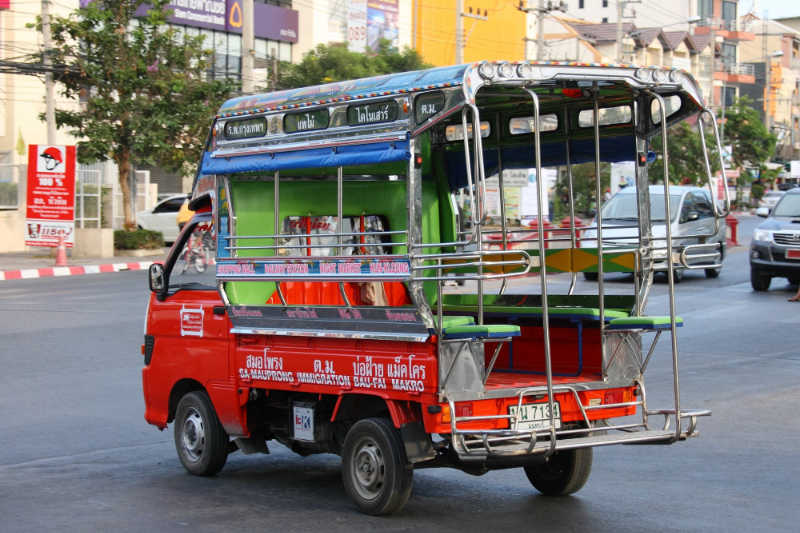 Songthaew – shared mini bus transport popular with local Thais and cheap to use
Songthaew – shared mini bus transport popular with local Thais and cheap to use
MINIBUS AND LONG DISTANCE BUS
Like songthaew, Thailand’s minibus are shared. Except minibus make long distance commutes also. Minibus are very popular for taking travelers from Bangkok to Hua Hin and ports on the east coast where passengers can catch ferry rides to the islands of Koh Chang and Koh Samet.
Long distance bus are cheaper with frequent service though take a little longer to reach a destination.
Minibus and Bus service for long distance travel are located in Bangkok’s three bus station terminals:
- Mo Chit 2 Bus Terminal (New Mo Chit) – Minibus servicing North and Northeast regions
- Ekkamai Bus Terminal – Eastbound regions
- Southern Bus Terminal – Westbound regions
Minibus are comfortable and air conditioned with 10 to 12 person capacity. Fares start from 150THB and increase on distance. For example a minibus fare from Ekkamai Bus Terminal in Bangkok to Pattaya cost 130THB (1 hours) while to Hua Hin (4 hours) cost 180THB.
As a note minibus service have reputation for unsafe drivers. So keep your seatbelts on at all times.
TRAIN TRAVEL – BTS (SKY TRAIN) AND MRT (SUBWAY TRAIN)
Currently Thailand’s capital city, Bangkok is the only city in the entire country with a metropolitan train system.
There are two train systems servicing greater Bangkok with planned future expansions:
- BTS SKY TRAIN – These trains run on elevated platforms about the busiest streets of central Bangkok.
- MRT SUBWAY TRAINS – Bangkok’s official subway trains also run below busy sections of Bangkok. But also local residential areas in parts of Bangkok.
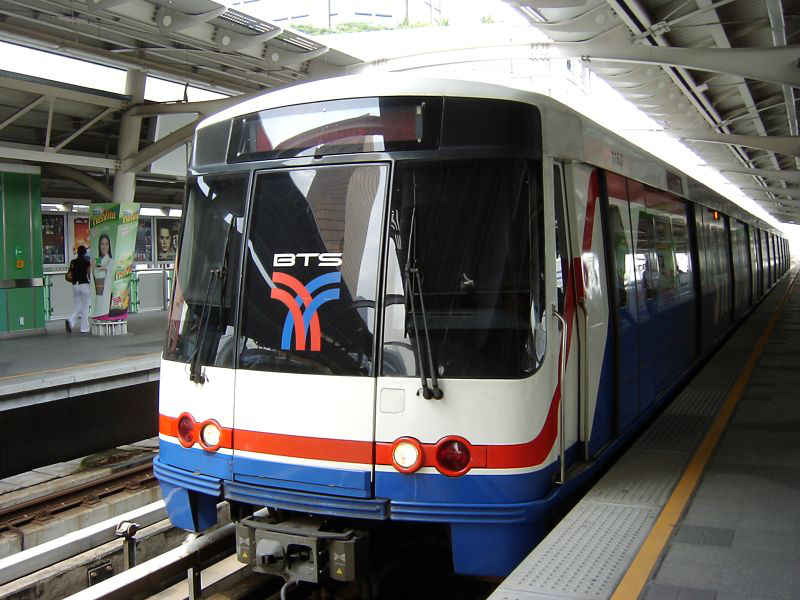
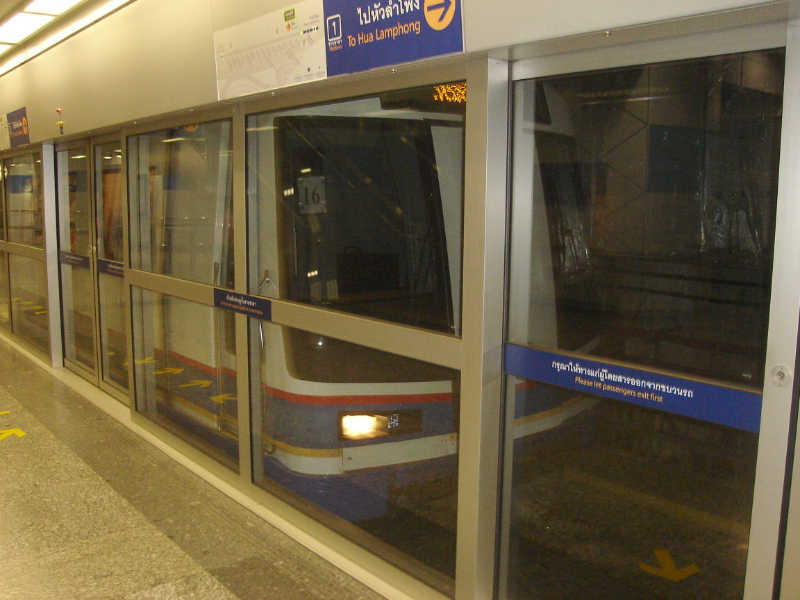
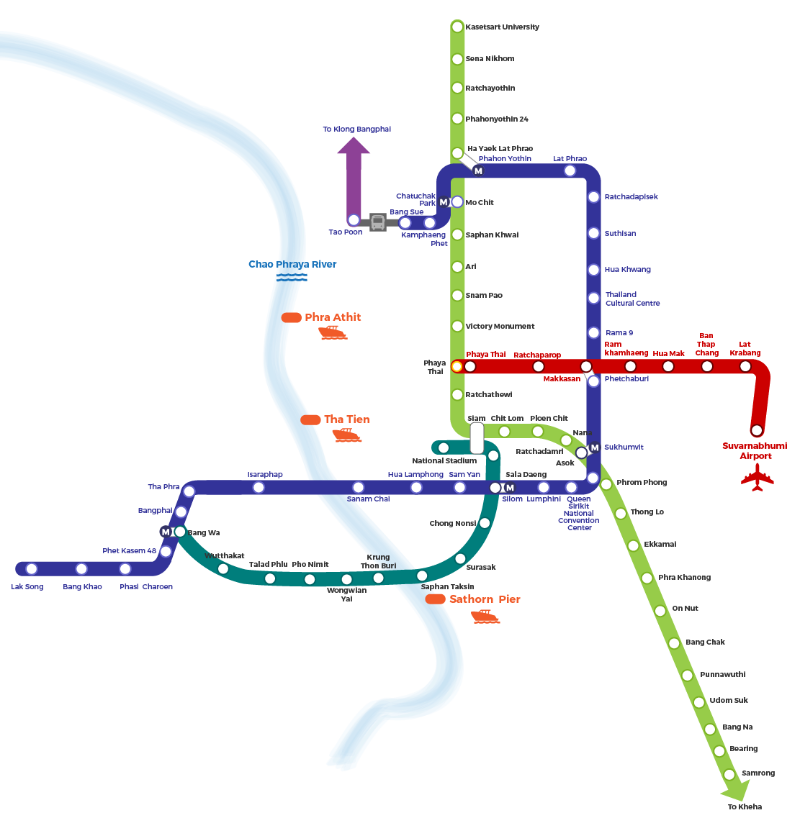
Thailand also has national rail service reaching more parts of Thailand. Though to keep this section short here is the best information on Thailand train travel I’ve found.
FOOD IN THAILAND
Thankfully Thai food is not centered around all things spicy. Although there are regional delicacies, particularly in the northeast and south of Thailand that make you feel like you ate a flamethrower.
While the foods of central Thailand are more mellow with just enough heat in the dish to remind you where you are.
Whether or not you can take the heat of a chili pepper with the power of nuclear bomb or not you will be able to find Thai foods that will suit your taste. Especially when you’re traveling with children.
THAI FOOD
Sweet, sour, salty and of course spicy. Thai food uses simple fresh ingredients, all or some combination of the four flavors to create a complexity that keep you coming back for more.
THAI-CHINESE FOOD
Through the years, Thailand’s food history was influenced through cultural interactions. The Chinese however has carried the most influence the time when immigrants from Southern China came and added their take on Thai cuisine.
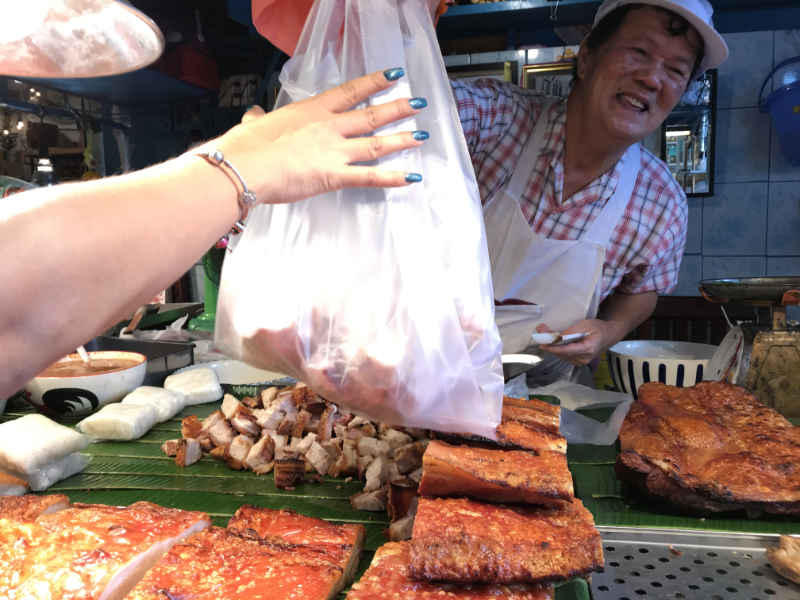 This shop sells roast pork, Chinese style
This shop sells roast pork, Chinese style
THAI-MUSLIM FOOD (HALAL DINING)
4.3% of Thailand’s total population are muslim. According to Halal Food Science there are 3500 Halal certified restaurants in Thailand. And there are many pockets of neighborhoods throughout Thailand where muslims reside.
One of the my favorite dish is Khao Mok Gai which is Thailand’s take on chicken biryani. You can find Khao Mok Gai in most mall food courts and definitely near muslim neighborhoods.
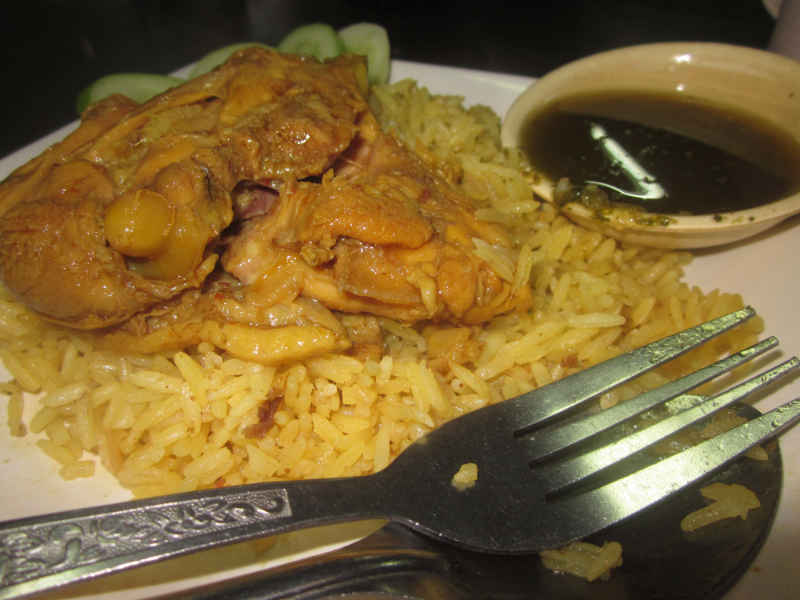 Khao Mok Gai (ข้าวหมกไก่) is Thailand’s very own chicken biryani dish.
Khao Mok Gai (ข้าวหมกไก่) is Thailand’s very own chicken biryani dish.
INTERNATIONAL FOOD IN THAILAND
All the major travel destinations in Thailand have a Western international food scene. The most popular is Italian and there has been a surge of South American restaurants, particularly Mexican. You can also find Greek restaurants and wine bars with steaks and chops.
COMMON SCAMS
The Wayfaring Soul Travel Tip #98 – “Where ever there are tourists there are scammers.”
Overall serious crimes against foreigners in Thailand are few and far in between.
What foreign tourist do face possibly on a day to day basis while hopping from one tourists attraction to another are “motivated salespeople” looking to steer you away from your original destination.
While some scams are rather elaborate. They’ll take you to tour of “secret temples” but there will be a cohort speaking near perfect English trying to sell you something.
If you do want to take a tour than you might as well look for a legitimate tour company with local guides such as takemetour.com.
Tuk tuks and taxis parked outside of hotels where foreign tourists are plenty should be avoided. They have no interests in taking you to cultural sights and attractions. But instead to gem shops and clothing tailors that pay them commissions.
These days it is very easy to find the information you need on the internet. Without relying on hearsay. And if anyone approaches YOU near tourist attractions its most likely they are trying to get you to buy something from somewhere.

